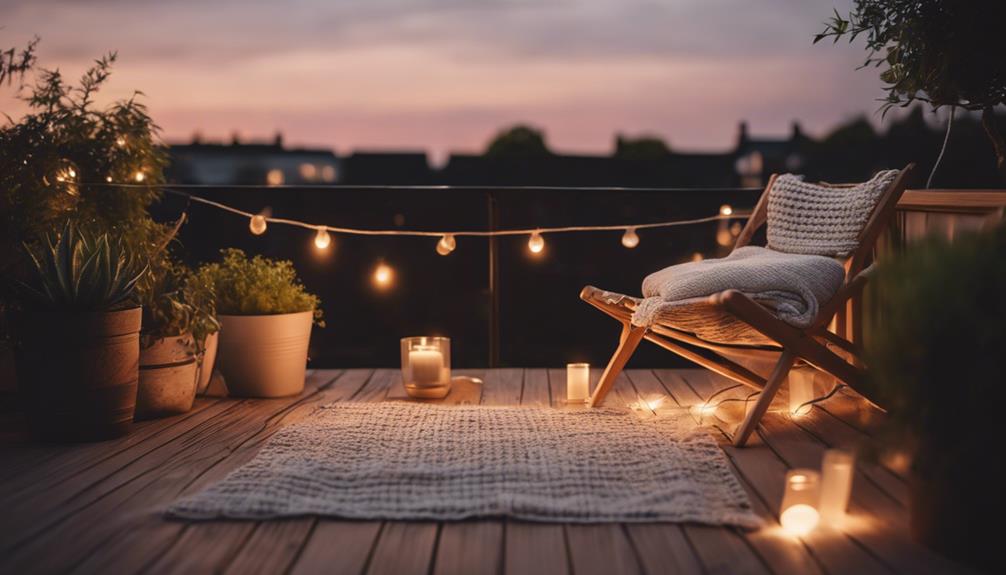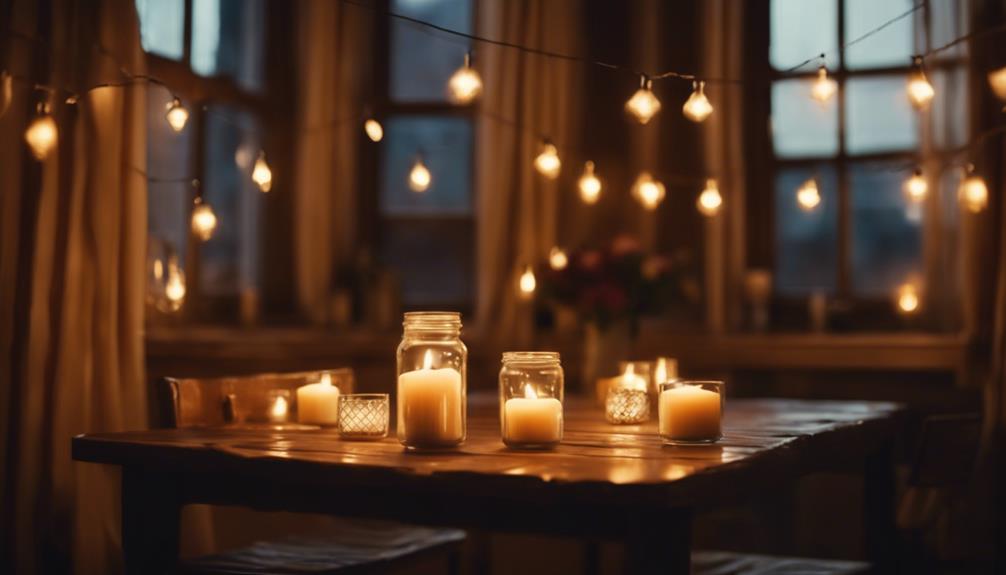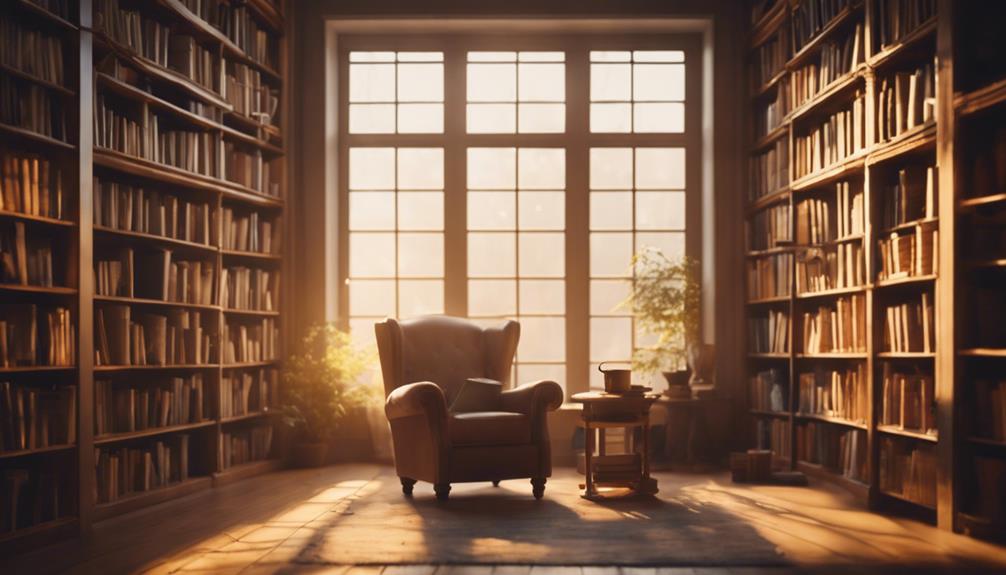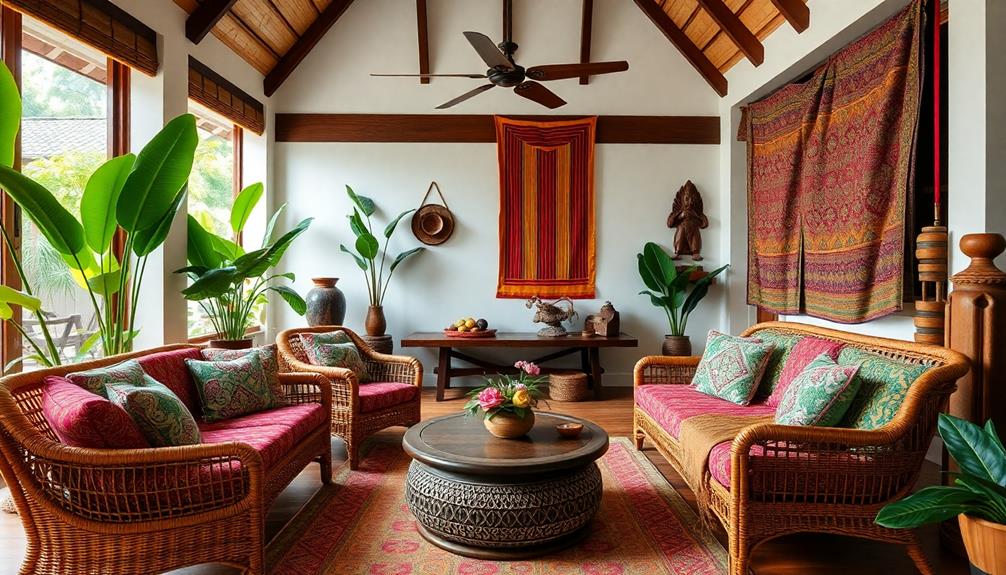You can easily add country flair to your dining room by focusing on colors, textures, and carefully chosen decor. Stick to a neutral palette to let rustic elements shine, while soft pastels can warm up the space. Incorporate natural materials like reclaimed wood for a cozy feel, and mix textiles such as linen and vintage rugs for depth. Vintage lighting, like wrought iron candle sconces or antique chandeliers, can enhance the ambiance. Finally, consider charming decorative pieces, like hand-painted vases or distressed wall art, to capture that country essence. Discover how to bring these ideas together beautifully!
Key Elements

When you're designing your dining room with country flair, the color scheme, materials, and textures play an essential role.
You'll want to choose warm, inviting colors and natural materials that create a cozy atmosphere.
Incorporating various textures can enhance the rustic vibe, making your space feel both charming and comfortable.
Color Scheme
Creating a country-style dining room starts with a neutral color palette that forms a serene backdrop, allowing rustic charm to shine through without overwhelming the space. Warm whites, like Alabaster by Sherwin Williams, are essential for achieving this effect. Pair these neutral colors with soft pastels to add warmth and depth, creating an inviting atmosphere that feels welcoming.
To maintain a cohesive look, use a limited color scheme that highlights your room's architectural features. This approach guarantees that natural light enhances the overall ambiance, making your dining experience even more enjoyable. Consider introducing accent colors strategically to draw attention to statement pieces or decorative accessories, ensuring they complement your chosen palette.
Textures play a significant role in reinforcing the country aesthetic. Incorporate materials like linen for chair covers or a vintage area rug, adding visual interest and tactile warmth without overwhelming the color scheme. By focusing on these elements, you'll create a balanced and charming dining room that reflects the cozy essence of country living while keeping it elegant and understated.
Materials
Natural materials are key to achieving that cozy country flair in your dining room, setting the stage for a warm and inviting atmosphere. Start with a reclaimed wood dining table; its rich wood tones evoke a rustic charm that instantly elevates the space.
Pair it with wooden chairs to enhance the cohesive look, guaranteeing they also feature natural textures that contribute to the aesthetic.
Don't shy away from soft textiles; linen or cotton chair covers can introduce comfort and warmth while maintaining an elegant vibe. Consider adding a vintage table runner to tie it all together, creating an inviting focal point for family gatherings.
Incorporate vintage dishware and glassware as decorative elements on your table. These pieces not only enrich the dining experience but also infuse your space with a sense of nostalgia and personal history.
For added depth, integrate stone accents like a brick fireplace or a stone accent wall, grounding your design in natural beauty.
Textures
Textures play an essential role in defining the cozy and inviting atmosphere of your dining room, so mixing materials like soft linens and rustic wood can elevate the overall design.
Incorporating natural materials, such as reclaimed wood for your dining table and chairs, adds warmth and a rustic charm that's crucial for that country flair. Layering different textures enhances visual depth; think soft linens for table runners paired with vintage woven baskets for storage.
Introduce textiles featuring floral patterns or toile fabrics in your upholstery and drapery to achieve a classic country aesthetic while keeping it sophisticated. You can also combine rustic elements like vintage dishware and glassware with modern accents to create an eclectic yet cohesive design that truly reflects your personal style.
Don't forget about your flooring! Textured options like vintage brick or distressed wood contribute to a welcoming atmosphere and enhance the overall charm of the dining room.
Essential Fixtures and Furniture

When creating a country-inspired dining room, the right fixtures and furniture can truly set the tone.
Start with a vintage farmhouse dining table as your centerpiece, and then add an antique crystal chandelier for a touch of elegance.
Don't forget to incorporate wrought iron candle sconces to enhance the cozy atmosphere.
Vintage Farmhouse Dining Table
A vintage farmhouse dining table often becomes the heart of your dining room, inviting family and friends to gather around its rustic charm. Typically crafted from reclaimed wood, this table serves as a central focal point, enhancing social interactions during meals. Its design features distressed finishes and visible grain patterns, contributing warmth and character to your space.
To create an inviting and eclectic atmosphere, consider pairing your vintage farmhouse dining table with mismatched chairs or upholstered seating in neutral fabrics. This mix not only adds personality but also encourages a relaxed dining experience. You can enhance the vintage aesthetic further by adding a table runner or placemats in soft pastels or floral patterns, introducing texture and color.
Incorporating a sideboard or buffet alongside your dining table offers practical storage solutions for dishware and linens while reinforcing the farmhouse ambiance. The rustic design elements of these pieces seamlessly blend with the table, making your dining room feel cohesive and charming.
With a few thoughtful choices, your dining room can exude that perfect country flair without feeling overdone, creating a welcoming space for all.
Antique Crystal Chandelier
An antique crystal chandelier instantly elevates your dining room, adding a touch of elegance and sophistication while enhancing the overall ambiance. This striking centerpiece draws the eye, creating a focal point that embodies charm and history—perfect for your country-style decor.
When you incorporate this stunning fixture, consider the intricate details and rustic finishes that harmonize beautifully with natural materials like wood and stone. These antique pieces reinforce the warm and inviting atmosphere characteristic of French Country design.
Choosing a chandelier with warm-toned crystals is key; they reflect soft, inviting light throughout the dining space, making it ideal for both casual family meals and elegant dining experiences.
To guarantee the best visual impact, position the chandelier at an appropriate height—generally 30-36 inches above the dining table. This placement allows for comfortable conversation without obstructing views, enhancing the overall dining experience.
Wrought Iron Candle Sconces
Wrought iron candle sconces not only complement the elegance of an antique crystal chandelier but also enhance the rustic charm of your dining room, creating an inviting atmosphere perfect for gatherings. These essential fixtures offer ambient lighting while infusing a touch of country flair into your space.
With various designs available, wrought iron sconces can serve as striking statement pieces, enhancing your walls' visual appeal and complementing your existing decor. The intricate detailing and organic shapes often found in wrought iron sconces allow them to blend seamlessly with vintage and antique furniture, reinforcing that cozy country aesthetic.
When you strategically place these sconces, they create a warm and welcoming environment, ideal for family gatherings or dinner parties. For added depth and texture, consider combining wrought iron sconces with candles of varying heights.
This decorating idea not only elevates the ambiance but also guarantees your dining room feels cozy and intimate without overwhelming the space. By thoughtfully incorporating wrought iron candle sconces, you'll achieve a harmonious balance between elegance and rustic charm, making your dining area a true reflection of your style.
Lighting Ideas

When it comes to lighting in your dining room, choosing the right fixtures can really enhance that country flair.
Think about incorporating rustic pendant lights, vintage lanterns, or charming Edison bulb fixtures to create a warm and inviting atmosphere.
Don't forget to reflect on antique brass floor lamps for added character and functionality.
Rustic Pendant Lights Selection
Choosing the right rustic pendant lights can elevate your dining room's country charm while providing essential illumination. Look for designs crafted from materials like wrought iron, wood, or weathered metal, as these can enhance the overall aesthetic. Vintage-inspired lantern shapes or distressed finishes work beautifully as statement pieces, adding character without overwhelming your space.
When selecting rustic pendant lights, consider the scale and height of your dining table. You want the lights to complement the table while ensuring that they provide ample light for your meals. Proper proportions create an inviting atmosphere, making your dining experience more enjoyable.
To foster a cozy dining environment, layer your rustic pendant lights with softer ambient lighting options, such as table lamps or wall sconces. This combination allows you to adjust the ambiance based on the occasion. Incorporating dimmable rustic pendant lights offers even more flexibility, letting you shift seamlessly from casual family dinners to intimate gatherings.
Vintage Lanterns for Ambiance
Integrating vintage lanterns into your dining room can elevate the ambiance, providing warm light that complements the rustic charm of your space. These lanterns can transform your dining area, creating an inviting atmosphere perfect for gatherings or intimate dinners.
Consider using lanterns made from natural materials like wrought iron or aged wood to reinforce that authentic country feel. Hanging vintage lanterns above your dining table not only serves as a statement piece but also draws attention to your central gathering area, fostering a cozy environment for meals.
To enhance the romantic ambiance, think about incorporating candles within your vintage lanterns. This adds a soft glow, ideal for special occasions or quiet evenings at home.
Mixing different sizes and styles of vintage lanterns throughout the room can create visual interest and a layered lighting effect, contributing to the overall character of the space without overwhelming it.
Antique Brass Floor Lamps
Antique brass floor lamps bring a warm, inviting glow to your dining room, perfectly enhancing its rustic country charm. These lamps feature intricate detailing and vintage-inspired designs, adding character without overwhelming your space. The warm tones of antique brass blend seamlessly with a neutral color palette, reinforcing the cozy atmosphere typical of country decor.
When you incorporate adjustable antique brass floor lamps, you gain the ability to focus the lighting on specific areas, like your artwork or a stunning dining table centerpiece. This targeted approach not only highlights your decor but also creates an intimate setting for meals and gatherings.
Opting for lamps with soft, diffused shades can further enhance the cozy atmosphere, allowing for a gentle illumination that encourages conversation and connection among your guests. The elegant look of antique brass combined with thoughtful lighting choices transforms your dining room into a welcoming haven.
Charming Edison Bulb Fixtures
Edison bulb fixtures bring a vintage charm that complements the warm glow of antique brass floor lamps, enhancing the cozy, rustic atmosphere in your dining room. These charming fixtures feature exposed filament bulbs that emit a soft, inviting light, perfect for family gatherings or intimate dinners.
You'll find Edison bulbs in various shapes, like globes, teardrops, and vintage-style candle shapes, allowing you to mix and match designs that suit your dining room's decor.
Consider installing Edison bulbs as statement pieces, like chandeliers or pendant lights, to elevate the visual appeal of your space while keeping that casual country vibe intact. Pairing these bulbs with rustic materials—think wood or wrought iron—will further enhance the country flair without overwhelming the overall decor.
You'll appreciate how these lighting options create a welcoming ambiance, making your dining room the perfect spot for sharing meals and memories. With the right Edison bulb fixtures, you're not just illuminating your space; you're adding a touch of charm that captures the essence of country living.
Decorative Elements

To elevate your dining room's country flair, consider incorporating hand-painted ceramic vases and vintage French porcelain plates as focal points.
These elements not only add charm but also create a personal touch that reflects your style.
Distressed wooden wall art can further enhance the rustic appeal, tying everything together beautifully.
Hand-Painted Ceramic Vases
Hand-painted ceramic vases add a charming touch to your dining room, showcasing exquisite craftsmanship that embodies the essence of French Country design. These vases often feature beautiful floral patterns or rustic motifs, making them stunning focal points that draw the eye and enhance your space.
By incorporating a mix of sizes and shapes, you can create visual interest on your dining table or sideboard, adding depth to the overall décor.
When you fill these vases with fresh flowers, they not only beautify the room but also contribute to a warm and welcoming environment. The natural beauty of the blooms combined with the artistic flair of the vases invites comfort and joy, perfect for family gatherings or dinner parties.
Opt for vases in soft pastel colors or muted tones that align with the neutral palette typical of French Country decor, ensuring a harmonious blend with your existing elements.
Vintage French Porcelain Plates
Vintage French porcelain plates, with their intricate designs and soft pastel colors, effortlessly elevate the charm of your dining room while serving as stunning decorative elements. These plates often showcase floral patterns or delicate hand-painted scenes that catch the eye and draw attention to your carefully curated space.
You can display a collection of vintage French porcelain plates on open shelving or as wall art, adding a touch of elegance and nostalgia that complements the rustic charm of a French Country design. Imagine walking into your dining room and being greeted by these exquisite pieces, each telling a story of history and craftsmanship.
Incorporating these plates into your table settings not only enhances the dining experience but also reflects your appreciation for artistry. When selecting vintage French porcelain plates, consider renowned manufacturers like Limoges or Sèvres. Their quality and artistry can remarkably elevate your dining room's aesthetic.
Distressed Wooden Wall Art
Displaying distressed wooden wall art alongside your vintage French porcelain plates enhances the rustic charm of your dining room, creating a warm and inviting atmosphere. This type of wall art perfectly embodies the essence of French Country design, emphasizing natural materials and a cozy, lived-in feel.
The weathered finish of distressed wood adds character and depth to your space, making it feel more intimate and welcoming. Look for pieces made from reclaimed wood, as they not only elevate the visual appeal but also promote sustainability by repurposing materials. You can find artworks featuring nature-inspired motifs or vintage elements, which contribute to the overall narrative of your dining area.
Pair the distressed wooden wall art with other decorative elements, like soft textiles and your vintage dishware, to achieve a cohesive and charming ambiance. This balance allows your dining room to reflect your personality while embracing that rustic charm you desire.
Flooring

When choosing flooring for your dining room, consider options like wide plank oak, reclaimed barn wood, or terracotta tile with a rustic finish.
Each of these choices brings a unique charm that enhances the country flair of your space.
You'll create a warm and inviting atmosphere that perfectly complements your decor.
Wide Plank Oak Flooring
Wide plank oak flooring brings a blend of durability and rustic charm that perfectly suits a country-style dining room. The wider planks, typically ranging from 5 to 12 inches, create a spacious and airy feel, enhancing the openness of your dining area. With oak's natural resistance to wear and tear, it's an ideal choice for high-traffic spaces where durability is essential.
Incorporating wide plank oak flooring into your home not only elevates the aesthetic but also adds a sense of warmth. The unique grain patterns and warm tones of oak create a cozy atmosphere, complementing the overall French Country design aesthetic beautifully.
Whether you prefer a light, natural finish or a deeper stain, you can easily customize the look to match your desired color palette and style.
Reclaimed Barn Wood Flooring
Reclaimed barn wood flooring adds a distinctive rustic charm to your dining room, showcasing unique imperfections and character that tell a story of its past. Each plank is distinct, offering a warmth that new materials simply can't replicate. This flooring option not only enhances the aesthetic appeal but also creates a cozy atmosphere that invites family and friends to gather around the table.
Using reclaimed barn wood is also an environmentally friendly choice. By repurposing old wood, you reduce the demand for new timber, contributing to sustainable building practices. Plus, the durability and strength of reclaimed wood often exceed that of new wood, thanks to its age and natural seasoning.
The warm tones and textures of reclaimed barn wood seamlessly blend with various design styles, from rustic farmhouse to modern chic. Installing this flooring can improve insulation and acoustics in your dining area, making it a practical choice for creating a comfortable space.
With reclaimed barn wood flooring, you're not just choosing a surface; you're investing in a piece of history that enriches your home's charm and character.
Terracotta Tile With Rustic Finish
Terracotta tiles with a rustic finish bring a timeless warmth to your dining room, enhancing its country-inspired charm. Their durability and classic appeal make them a perfect choice for achieving that cozy atmosphere you desire. Available in various sizes and shapes, you can arrange terracotta tiles in patterns like herringbone or grid, adding visual interest to your space.
The earthy tones of terracotta tiles, ranging from warm reds and oranges to softer beige hues, blend seamlessly with a neutral color palette typical of French Country design. This versatility allows you to create a harmonious look that complements your overall decor.
Another advantage of terracotta tiles is their natural porosity, which helps retain heat. This feature guarantees your dining area stays warm during colder months, further contributing to that inviting ambiance. To maintain their rustic charm, consider sealing them with a matte finish. This not only prevents staining but also preserves their authentic, aged look.
Incorporating terracotta tiles with a rustic finish into your dining room is a practical yet stylish way to infuse country flair without overwhelming the space.
Conclusion
By incorporating these key elements, you can easily add a touch of country flair to your dining room without going overboard. Incorporate natural materials such as wood and stone, and add some rustic touches like distressed furniture or vintage-inspired linens.
Country decor with antiques can also help to create a warm and inviting atmosphere, and can be easily incorporated through items such as antique dishes, vintage signs, or old-fashioned kitchen tools. These elements can add character and charm to your dining room and help to bring a sense of warmth and nostalgia to the space.
Focus on essential fixtures and furniture that blend rustic charm with modern comfort, and don't forget the lighting to set the mood.
Add some decorative elements that speak to your style, and choose flooring that complements your design.
With these tips, your dining room will feel warm, inviting, and perfectly balanced in country elegance.










